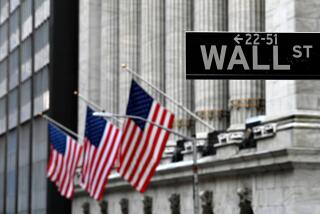Since You Asked: The New S & P Stocks
- Share via
Since a Street Strategies column published Dec. 24, many readers have e-mailed to ask the names of the year’s final three additions to the Standard & Poor’s 500 index. Several also asked whether any researcher has studied the usefulness of shorting stocks deleted from the S&P; 500.
The column proposed that investors consider buying and briefly holding stocks as they are added to the index.
The reason: Money managers controlling $500 billion in public and institutional funds tied to the S&P; 500 index must purchase such stocks within a short period. Since 1989, according to a Duke University finance professor’s research, those stocks have jumped an average of 7% between the day Standard & Poor’s announces they will join the S&P; 500 index and the day the stocks are actually added.
The three stocks announced on Dec. 19 for addition to the S&P; 500 on Dec. 31 all rose amid a relatively flat market. Thermo Electron (symbol: TMO) popped from $33 in initial trading on Dec. 20 to $38.375 on Dec. 31, a 16.3% gain; AutoZone (AZO) rose from $24 to $27.50, a 14.6% gain; and Frontier Corp. (FRO) rose from $22.125 to $22.63, a 2.3% gain.
I could find no studies on the viability of shorting S&P; 500 deletions from the index. The sample group would be small, because most deletions occur when stocks are merged out of existence or their companies declare bankruptcy.
However, the last three deletions occurred when S&P; decided that the market capitalizations of three restaurant companies had shrunk so much relative to the rest of the companies in the index that their price movements were having minimal effect.
As it turns out, each would have been a successful short. The three deletions were Shoney’s (SHN), which fell from $7.75 to $7 by Dec. 31, a 9.7% decline; Ryan’s Family Steakhouses (RYAN), which fell from $7.875 to $6.875, a 12.7% decline; and Luby’s Cafeterias (LUB), which fell from $22.50 to $19.875, an 11.7% decline.
All of the stocks listed above rose or fell on trading volume up to six times normal on Dec. 31. Shoney’s, for instance, typically has 75,000 to 300,000 shares trade each day; trading volume Dec. 31 was 3.2 million shares.
Incidentally, S&P; failed to update its Index Services home page on the Internet (https://www.stockinfo.standardpoor.com/indexes/idxnews.htm) late last month with timely announcements of the AutoZone, Frontier and Thermo Electron additions.
Vice President Elliott Shurgin acknowledged the error and vowed to display all press releases on the additions by 5 p.m. on announcement day.
The Web site announced Jan. 2 that the next addition to the index would occur at the end of trading today, when Healthsouth (HRC) replaces Boatmen’s Bancshares, which is being acquired by NationsBank.
More to Read
Inside the business of entertainment
The Wide Shot brings you news, analysis and insights on everything from streaming wars to production — and what it all means for the future.
You may occasionally receive promotional content from the Los Angeles Times.










